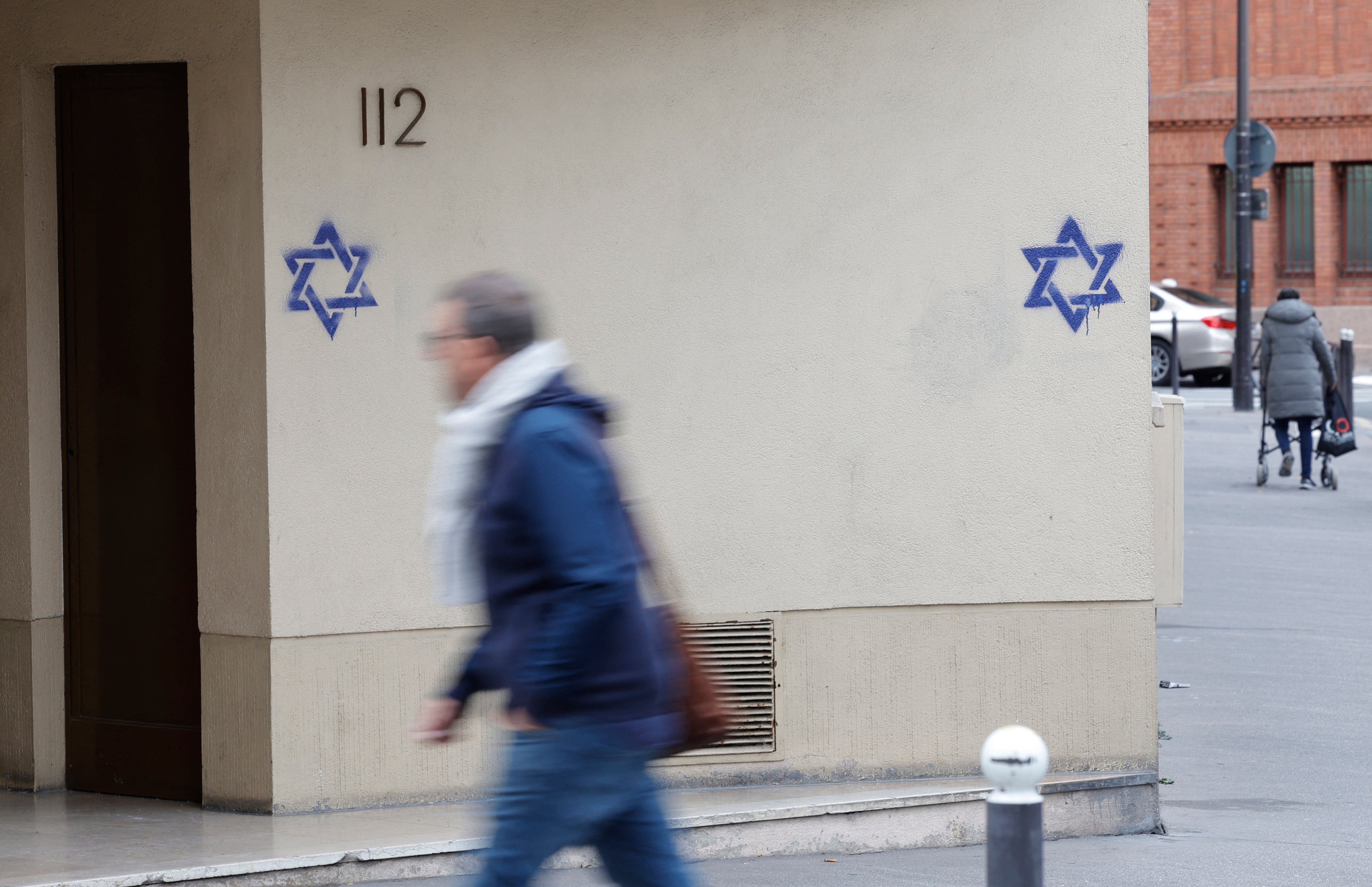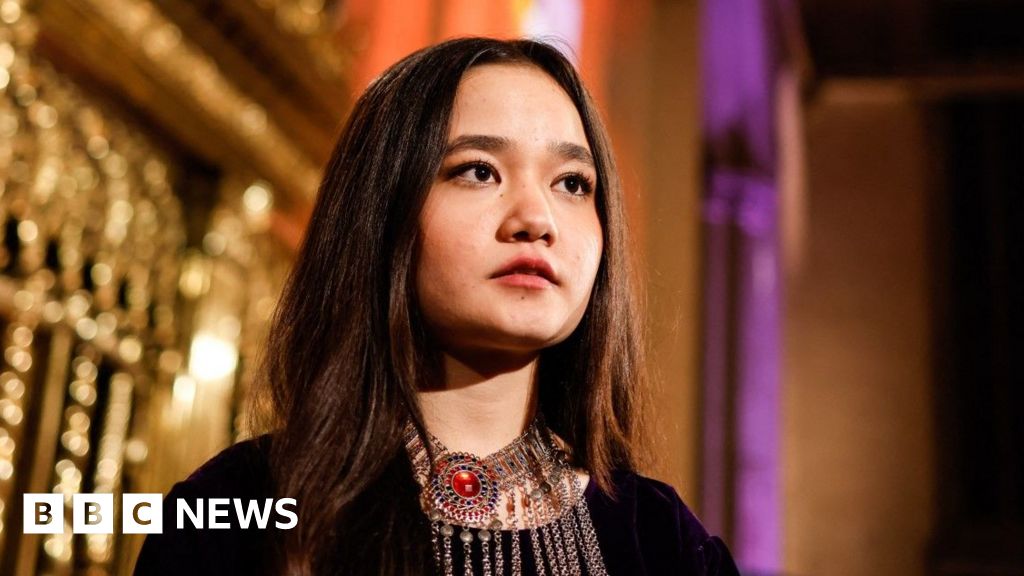World
Trapped in Gaza: One woman’s nightmare of a year − with no way out during war

All Nour Swirki ever knows is she must find a way to evacuate.
But for different reasons, she can’t do it. Sometimes, it’s because the car that’s supposed to whisk her away to safety − away from Gaza to her children in Egypt − won’t start. Sometimes, her bags are too heavy to carry.
Sometimes, crowds hold her back. Often − most of the the time − she doesn’t understand why she can’t leave.
As of Monday, it’s been a year of fighting in Gaza between Israel and Hamas, a consequence of the militant group’s Oct. 7 attacks that killed 1,200 people in Israel and saw 251 kidnapped and dragged back to the Palestinian enclave. Since the war broke out, more than 41,000 people in Gaza have been killed, according to the Hamas-run health ministry.
Much in Gaza, besides lives, has been lost during this period: entire families, whole neighborhoods, the Palestinian enclave’s rich cultural heritage from mosques to libraries. The war has changed the Middle East. Hamas’ leadership has been decimated, but with a negotiated cease-fire still out of reach, the war has threatened to spark a wider regional conflict between Israel and Iran, as well as Hamas allies in Lebanon and Yemen. It’s ushered in fresh scrutiny of the decades-old plight of Palestinians. It has brought tragedy and trauma to Israel but also isolated it on the world stage. The war could impact the U.S. election.
For Swirki, 36, a Palestinian TV journalist who has recurring nightmares about never being able to escape Gaza, it’s been a year of doing her job while trying to survive herself. That’s something that as of late September at least 116 journalists and media workers have not been able to do, according to the Committee to Protect Journalists.
“My dreams are all about evacuating because this is my real-life nightmare,” Swirki said.
As the war has dragged on, time for Swirki has become indistinct. It’s become harder for her to understand or even think about the devastation of the past year. Many of the people and things she knew, many of the streets she knew, are no longer there to see or touch. There have been too many losses and separations for her to make sense of.
Two separations in particular weigh heavily on her as the war hits its one-year mark because of the promise they hold.
Their names are Jamal, 11, and Alia, 13. Her children. She and her husband, Salem, also a journalist in Gaza, evacuated their kids to Cairo in April, where they are staying with their mother’s sister and parents.
The family of four has not been together since. In her darker moments, Swirki wonders if they ever will. “I am relieved they are in a safe place. I miss them so much,” she said. “I just want to survive to meet them again.”
One year in Gaza, four times displaced
In Gaza, the experiences of the Swirki family over the past 12 months are not atypical.
They are among almost 2 million Gazans − 9 out of every 10, according to the United Nations − who have been displaced internally at least once since Oct. 7, 2023.
Their house in Gaza City was destroyed in an Israeli airstrike. They have fled for safer shelter four times. Like most Gazans, they have lacked access to adequate food, clean water, sanitation and health care.
They have seen family, friends and colleagues killed with little time or physical space to reflect on that grief.
A week before Hamas attacked Israel on Oct. 7, Nour Swirki was posting on Facebook about how she found it funny that her son was making short videos about soccer game results rather than studying for his math exam.
A year later, Swirki wrote on the same platform, “Every morning I wake up here the shock still hits me.”
“I’m thinking about how life around us passes in parallel worlds far from here, and how one can not be present in his life but only witness its passing. Things and time pass without meaning, without purpose,” she writes.
In Rafah, in southern Gaza near the border with Egypt, the family escaped the misery of having to live in a tent, where camps stretch for miles and spill into empty or decimated fields, streets and lots.
But the shelter they were in didn’t provide any extra comforts.
No one felt safe.
Jamal and Alia Swirki spent large parts of their day looking for firewood to cook with or standing in line for water.
Studying was out of the question. There were few books. Internet and cellphone service was sporadic.
Both children eventually contracted hepatitis, caused by drinking water contaminated with raw sewage.
“There was no infrastructure. There was literally no place to go,” Swirki said of the family’s time in Rafah. “Our clothes were dirty. There was no way to wash. It was very tough for me as a mother.”
In February and March, it became apparent that Israel was preparing to launch an all-out offensive on Rafah as part of its efforts to hunt and defeat Hamas and free Israel’s hostages.
Already, Israel’s military had launched airstrikes on Rafah that appeared to Palestinians sheltering there to be largely indiscriminate, though Israel disputed this. On Feb. 12, more than 100 people died, according to estimates from the Palestinian Red Crescent Society and other other aid groups, in Rafah in airstrikes that some media described as the “Super Bowl Massacre” because it coincided with the Super Bowl.
“The psychological condition of the children was getting worse. They were losing weight. They kept asking us to take them to a safer place,” Swirki said. “They couldn’t stand hearing the bombing and shelling.”
Yet for the Swirkis, the decision to send their children to Cairo still wasn’t an easy one. In fact, they had been discussing it intensely on and off for months. They were hopelessly conflicted about what to do.
As journalists, they felt obligated to be in the field as much as they could to document the war’s impact on Gaza. Many of their colleagues had paid the highest price − their lives − to do just that. Over and over again journalists in Gaza in the last year have spoken, sometimes live on air, about how Israel’s forces have phoned them up and told them that they and their families are going to be targeted for attack. Then the attacks came. Israel strongly disputes any suggestions it is deliberately targeting journalists but the belief that they are is widely shared among Gaza’s journalists.
“These shields and these helmets will not protect us, they are just slogans that we wear,” said Salman Al-Bashir, a TV news anchor and reporter for Palestine TV as he removed his protective gear with the word “Press” emblazoned across it and broke down on air in November after learning his colleague had been killed while reporting outside a hospital.
For the last year, Nour Swirki has felt this same sense of ultimate vulnerability.
She worried, too, that if the children stayed in Gaza they might be killed. There were too many examples of that.
However, she felt that Alia in particular, at a time in her life when she was dealing with the onset of her menstrual cycle, needed to be close to her mother for guidance and help navigating the changes to her body.
The family received a phone call on April 16 saying the kids were on an approved exit list for the next day.
The suddenness of it appeared to make the decision for them.
Nour Swirki didn’t take any pictures of the family together as they put Jamal and Alia on a bus in Rafah and handed over their passports. She felt that to do so was to tempt fate and acknowledge she may never see them again.
She hoped she was making the right decision. A few weeks later, Israel captured the Rafah border crossing, closing it to all civilians as part of a military offensive against Hamas in the area.
“I didn’t know how to feel,” said Alia Swirki in a phone interview from Cairo. Her mother was also on the call.
“I didn’t want to be leaving my parents. I was also happy to be going somewhere safe, more comfortable.”
‘I’m going to lose them all one by one’
In recent weeks, Israel’s military has withdrawn most of its troops from Gaza, and major ground operations there appear to be slowly winding down as Israel focuses its attention on Iran-backed Hezbollah, which has launched, from its base in Lebanon, more than 9,300 missiles at Israel since Oct. 7, according to government figures. Israel assassinated Hezbollah leader Hassan Nasrallah in late September and has started what it’s called “limited” ground incursions into Lebanon to further erode the group’s fighting capabilities. Iran is bracing for Israeli retaliation after firing about 200 ballistic missiles at Israel for its killing of Nasrallah and other Hezbollah leaders.
Cease-fire and hostage deal talks between Israel and Hamas, conducted by mediators Qatar, Egypt and the U.S., have been stalled for months. And in the year since Israel launched a war in Gaza as a result of Hamas’ Oct. 7 attacks, the humanitarian impact has been so enormous the numbers struggle to convey the story.
In addition to the tens of thousands of Palestinians who have have been killed, a further 10,000 are still missing, likely buried under fragments of stone, brick, steel, concrete and other debris.
According to the U.N., 60% of Gaza’s buildings are damaged or destroyed entirely. More than half of residential homes are gone. Only 17 of Gaza’s 36 hospitals are functional, most only partially. An estimated half a million people in Gaza are facing what the U.N. and other aid groups describe as “catastrophic” food insecurity.
Many of Gaza’s schools, universities, sports halls, roads, supermarkets and places of worship no longer exist. Aid groups say hundreds of children who need life-saving surgeries and urgent medication have not been able to leave Gaza for the West Bank, a separate Palestinian enclave controlled by Israel’s military, or countries such as Saudi Arabia and the United Arab Emirates. In mid-September, the World Health Organization was able to evacuate dozens of sick kids.
Fadi Abed, a Gazan who works for the humanitarian medical organization MedGlobal and has been helping vaccinate children against polio, said that after a year of war, the thing that shocks him the most is when he sees buildings in Gaza that are still standing, not the other way around.
“This should tell you what it’s like here,” he said.
Gaza’s Health Ministry doesn’t distinguish between civilians and Hamas fighters in its death count, but it says that, as of Sept. 25, at least 6,297 women and at least 11,355 children have been killed in Israel’s latest war with Hamas.
Israel’s military says that more than 17,000 of those it has killed in Gaza have been militants. About 350 Israeli soldiers have died in combat in Gaza since Oct. 27, when its ground operation was launched.
The death toll on the Palestinian side has not been confined to Gaza. About 600 Palestinians have been killed in the West Bank since Oct. 7 last year, according to the U.N., as Israel has increased assaults there as part of what it says are operations to root out terrorists. More than 2,000 people, according to Lebanese authorities, have also been killed in Lebanon as Israel has targeted Hamas’ ally Hezbollah in special operations and missile attacks in Beirut and other parts of the country.
Israel has fought multiple wars with Hamas and other Palestinian militant groups, as well as coalitions of Arab-nation forces, as part of an Israeli-Palestinian conflict that’s one of the longest running in modern history. At the center of this conflict is a dispute over territory, security, Israel’s right to exist and Palestinian rights and self-governance.
But the most recent war, the bloodiest in their shared history, began when Hamas attacked Israel on Oct. 7.
“The thought that was invading my head was: ‘I’m going to lose them all one by one,'” said Tareq Hajjaj, a Gazan who entered Egypt in April with his wife and son about a month before Israel closed the Rafah crossing.
Hajjaj is a journalist whose efforts to stay alive in Gaza as he chronicled the war USA TODAY previously wrote about. He had been offered an earlier opportunity to leave Gaza, but he turned it down because he was not able to take his blind mother, who suffered from diabetes. After she died from lack of medication, he was offered another chance.
‘Did we die?’: A week in the life of a journalist in the Gaza Strip
Hajjaj has not found exile easy. He is continuing to report on Gaza from Cairo. He wants, ultimately, to join his brother in the U.S. In most respects, his life is immeasurably better. He can take his 19-month-old son, Qais, on play dates or to the pool. His family has regained many of the simple freedoms they lost in Gaza.
But he is having trouble forgetting.
“Wherever I go, I only think about Gaza,” he said.
“When I see a bridge, for example, I think: ‘Why can’t we in Gaza have bridges?’ When I see a road, I say to myself: ‘Why don’t we have such roads in Gaza? Why can’t we live this way in Gaza, with freedom? Why can’t we have an airport? A train system? Why do we, as Palestinians, have to leave our country to feel safe?'”
There are only three land border crossings in and out of Gaza. Two are controlled by Israel and the third, the Rafah one, had been administered by Hamas until Israel captured it in early May.
Too many Gaza stories to remember them all
Since May, Nour and Salem Swirki have been living in a tent that is situated on the grounds of a hospital in Deir al Balah, in central Gaza. About 100 other journalists are also living in this area.
There is an Internet connection and other facilities that help them in their work. They share resources.
At the entrance to her tent, Nour Swirki has pinned a scrawled, handwritten note that manages to strike both a lightly humorous and defiant tone: “Nour villa: displaced Gazan woman, mother and journalist,” it reads.
Swirki says she feels safer being close to the hospital even though Israel’s military over the past year has repeatedly struck medical facilities in Gaza, where it says Hamas hides weapons or themselves.
She has covered too many stories over the past year to remember them all.
The one’s she can’t forget usually involve children. Some who have had arms or legs amputated. Others who she sees on the street asking for food. The ones whose small, floppy, lifeless bodies show up at the hospital.
“I’m not sure how a parent can survive losing their children,” she said. “It’s a kind of madness.”
She is close to her dad, a businessman who was in Egypt when the war started, whom she yearns to hug.
The dreams of escape are intensifying and arrive nearly nightly.
“I miss feeling safe and protected,” she said.
She and her husband are in contact with their children.
They text and call each other throughout the day, all day.
“We wake up together and go to bed together,” she said.
They get updates on whether Ali has been practicing her routines for “Dabkeh,” a popular Palestinian group dance that is accompanied by traditional wind instruments and singing. (She has. But it’s not the same in Cairo, she said.)
Jamal is still making videos about soccer, though now they are for his own TikTok and YouTube channels.
The family tend to avoid video calls because when they see each other, everyone starts crying.
“Sad,” was the only word Jamal offered when asked to describe his feelings about being separated from his parents when he briefly joined the call with his sister and mother.
There have been moments − precious ones − of levity and high spirits, too.
On July 18, Nour Swirki’s birthday, a man called her out of the blue asking where she was because he had something to deliver to her. She was out reporting. When they found each other he delivered a cake.
It had pieces of pineapple and orange on it.
A paper message was attached to it.
“From the displaced people in Cairo to the displaced people in Gaza. Happy birthday,” it read.
There were no candles to light or blow out.
Nour Swirki still made a wish. She made two.
Illustrations by Veronica Bravo and Ariana Torrey, USA TODAY. Photos by Nour Swirki










